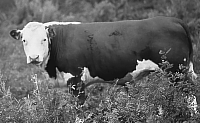7.3 Stand level biodiversity - range considerations
The following sections are provided to raise an awareness of the biodiversity of rangelands.
Most comments apply to permanent range (NDTs 4, 5, and related ecosystems in NDT3) in the Biodiversity Guidebook (PDF, 8MB). Additional comments applying to transitory range (the other NDTs) are specified.
NOTE: As per the above,
- Permanent ranges are areas that produce substantial livestock forage throughout most or all-successional stages.
- Transitory ranges are those areas that provide range for a brief period following stand-initiating fires or timber harvest but will advance to closed forests.
- Potential Natural Community (PNC) is the community that would be established if all successional sequences were completed without further human interference.
Rangelands consist of a variety of plant communities, plant species, and physical environments that provide opportunities for nesting, foraging and cover for wildlife as well as productive forage and shelter for livestock. Range occurs on many of the biogeoclimatic zones within British Columbia.
Approximately 80% of Crown range in British Columbia is forested. The harvesting of forests and the harvesting of forage by livestock and wildlife often occurs on the same areas. Consequently, it is important that objectives for range biodiversity be considered in planning and conducting stand level forest activities.
- Contact with the Resource Officer—Range and the Forest Ecosystem Specialist for the area is a necessary step.
Are there other range considerations? If so, what are they? What are some examples of how these range considerations can be used when planning and conducting stand level forest activities?
Both forest harvesting and grazing can affect plant communities. While biodiversity objectives for forest are concerned mainly with the forest overstorey, biodiversity objectives for range relate to the understorey. Grazing use can move the plant community away from the Potential Natural Community (PNC) that forms the central concept for achieving biodiversity objectives for permanent range.
- A general objective is restoring and maintaining the range of natural temporal and spatial distribution of range ecosystems.
- Range use plans typically require strategies for addressing landscape level biodiversity objectives and for maintaining desired plant communities.
- Other guidebooks with relevant information include: Riparian Management Area; Identified Wildlife Management Strategy; and Community Watersheds.
Range biodiversity requirements should be considered in the context of the overall objectives for the area. These objectives are established in higher-level plans.
- On permanent range, stand level practices will often benefit livestock and wildlife by ensuring steady supplies of forage when they promote a natural mix of overstorey seral stages and the maintenance of potential natural communities (PNCs). For example, either regular prescribed burns or low-impact logging combined with burning, natural regeneration and regular underburns may allow a site to quickly emulate its PNC. On transitory range stand level practices may benefit range use but not necessarily PNC.
Seral Stage Definitions:
- Early — seral 0-25% (similar to PNC)
- Mid — seral 25-50%( similar to PNC)
- Late — seral 50-75%( similar to PNC)
- PNC — climax 75-100% of PNC
Go to next page

A steer on a range in British Columbia.



